Alfama:
The Alfama is originally a fishing community, with a labyrinth of narrow, winding cobbled streets and alleys that can be pretty steep. Despite the fact that Muslim houses can no longer be found, the streets are a relic of the Islamic culture, where little value is given to the outside, but more to the interior of the houses, although they are generally relatively small. Chances are you’ll get lost in the maze of little streets, but you’ll often get back to one of the many viewing points, the Miradouros, literally: golden view, where you can enjoy the amazing vistas of the city.
Castelo:
The neighbourhood Castelo is located above the Alfama and is best known for the Castle of Saint George, Castelo de São Jorge.
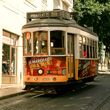 Eléctrico 28:
Eléctrico 28:
Do you want see the many sights of Lisbon, without having to climb too much? Then the eléctricos, the trams, are the alternative to climbing the steep streets of Lisbon. Tram 28 is a classic old tram that runs from the Martim Moniz Metro station to the Alfama, down into the Baixa, through the Chiado, up Bairro Alto to the Campo Ourique (Prazeres).
Link: Route Tram 28 (EN)
.
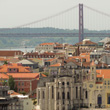 Miradouro da Graça:
Miradouro da Graça:
From Miradouro da Graça you can enjoy the panoramic views over the city (see the image above this page) and castle , Castelo de São Jorge. The adjacent open-air café is a favourite amongst the young and old, because it is situated under the many trees that provide shade in the often blazing sunshine. Behind the Miradouro, at Largo da Graça, you can find the Igreja e Convento da Graca, a church and monastery originally from 1271, and rebuilt after the earthquake of 1755. The interior contains many gold leaf decorations, tiles and painted ceilings.
Tram 28, stop: Graça
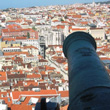 Castelo de São Jorge:
Castelo de São Jorge:
The foundations of this fort are from the 2nd century, but archaeology shows that people have been living here since the 6th century BC. After the Moors were defeated in 1147 at the siege of Lisbon, the King Dom Afonso Henriques turned it into a castle. During the 1755 earthquake, much of the 6000 m² surface area suffered severe damage. In 1938 restoration of the medieval castle begun.
Tip: This old fort is a great place to spend a morning or an afternoon. You can take a gentle stroll along the castle walls, climb the towers, and enjoy a unique view over the city and the river Tagus.
Address: Rua do Chão da Feira (entrance gate)
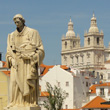 Largo das Portas do Sol:
Largo das Portas do Sol:
On the Largo das Portas do Sol stands the statue of São Vincente, the patron saint of Lisbon, holding a boat and two crows, the city symbol. Again you can find a great view over the city, but this time from a walk-in terrace on the rooftop of a house. You can see the church and monastery of São Vicente de Fora in the distance on the hill in the east.
Address: Largo das Portas do Sol
.
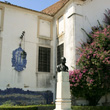 Miradouro de Santa Luzia:
Miradouro de Santa Luzia:
The Miradouro of Santa Luzia is a quaint little park, built on the remains of the Moorish fortress wall where the pergolas are covered with grape vines. You can enjoy the landscape of Lisbon, sitting serenely on benches built into the walls adorned with blue painted tiles. The adjacent church, Igreja de Santa Luzia, are the headquarters of the Order of Malta in Portugal and on the outer wall you can see two blue-painted tile panels. One panel is the map of the city centre of the earthquake of 1755, the other is a representation of the invasion of the castle by the Christians in 1147.
Address: Largo de Santa Luzia
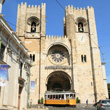 Sé de Lisboa:
Sé de Lisboa:
The Sé de Lisboa Cathedral is dedicated to Santa Maria Maior and built on the site of an ancient mosque shortly after the conquest of Lisbon from the Moors in 1145, commissioned by the first king of Portugal, Dom Afonso Henriques. Several earthquakes and necessary repairs later, there are different styles in this cathedral to admire, from Romanesque to Gothic. You can find the graves of the King Dom Afonso IV and his wife Dona Beatriz here, and especially the Gothic chapel makes a visit to this cathedral worthwhile.
Address: Largo da Sé
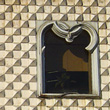 Casa dos Bicos:
Casa dos Bicos:
The house with the peaks, is a palace from the Renaissance (1523) strikingly decorated with diamond-shaped jagged rocks, and therefore also referred to as the house of diamonds. The two upper floors with Manuel-style arched windows were destroyed by the earthquake in 1755, and restored to their original state in 1982. The interior is also very special, due to the contrast between the black walls and marble staircase. The building was once used for salting fish, which you can see in the name of the street on which the building is found: Rua dos Bacalhoeiros, street of the cod-fishermen.
Address: Rua dos Bacalhoeiros 8
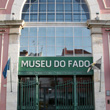 Museu do Fado:
Museu do Fado:
The Fado Museum is dedicated to the traditional Portuguese melancholically songs called Fado. In addition to a permanent exhibition with audiovisual presentations, tools, and wax statues, you can take lessons in Portuguese guitar, and singing. There are live performances in the auditorium regularly.
Address: Rua Chafariz de Dentro 1
.
.
.
 Panteão Nacional – Santa Engrácia:
Panteão Nacional – Santa Engrácia:
The Santa Engracia is a 17th century monument built in the Baroque style, which was turned into the Panteão Nacional, National Pantheon, in the 20th century. The most important Portuguese personalities such as presidents, writers and most influential Fado singer in history, Amalia Rodrigues, found their resting place here. There are also cenotaphs (empty graves) for seafarers such as Infante D. Henrique and Vasco da Gama, as well as the physical remains of the greatest Portuguese poet Luis de Camões.
Tip: in front of the church there is a flea market on Tuesdays and Saturdays, called the “Feira da Ladra”.
Address: Campo de Santa Clara
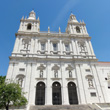 Igreja e Mosteiro de São Vincente de Fora:
Igreja e Mosteiro de São Vincente de Fora:
This church and monastery is dedicated to São Vincente, and has an imposing stone facade with two large bell towers. The walls of the monastery are covered with beautiful blue and white azulejos, typical Portuguese tiles, which show the stories of St. Vincent.
Tip: Take the stairs and climb the towers!
Address: Largo de São Vicente


Laat wat achter - Leave a Comment